It is easy to feel hopeless against a system, to accept that maybe this is our lot as the Negro race. But like the little people seen through Kester Kanayo Onyemaechi’s lens, look at the light.
By Ebri Kowaki
Kester Kanayo Onyemaechi came to a renaissance on a bus racing down the Benin-Ore-Lagos route, beside towering foliage and a traveling buddy, Adetola. She had asked the question that had started him down enlightenment, a simple, almost off-hand inquiry; ‘Why do you love taking pictures?’
He had been a professional photographer for four years at the time, and he was finally beginning to seriously critique his role as a photographer in society. The might of the camera, man’s salvation for a decaying memory, in his hands had to transcend merely shooting scenes that felt poetic, no? Kanayo confesses he is yet to answer the question in a way that satisfies him, yet from then on his work responded with worldbuilding frequencies to the nagging query.
Kester Kanayo Onyemaechi is a man of many hats; both in the conventional sense and because he is rarely photographed without one. The hats often conceal stories in their inner lining. In his life and photography, he holds up these liminal memories of pure living, experienced as love, or bliss, or even a sense of the preciousness of life, to the light, proclaiming them a salve and comfort in sorrow. The Southwestern-style fila worn in the photograph, a replica in memory of a friend who passed in 2023, exemplifies the idea of tangibly preserving the past.
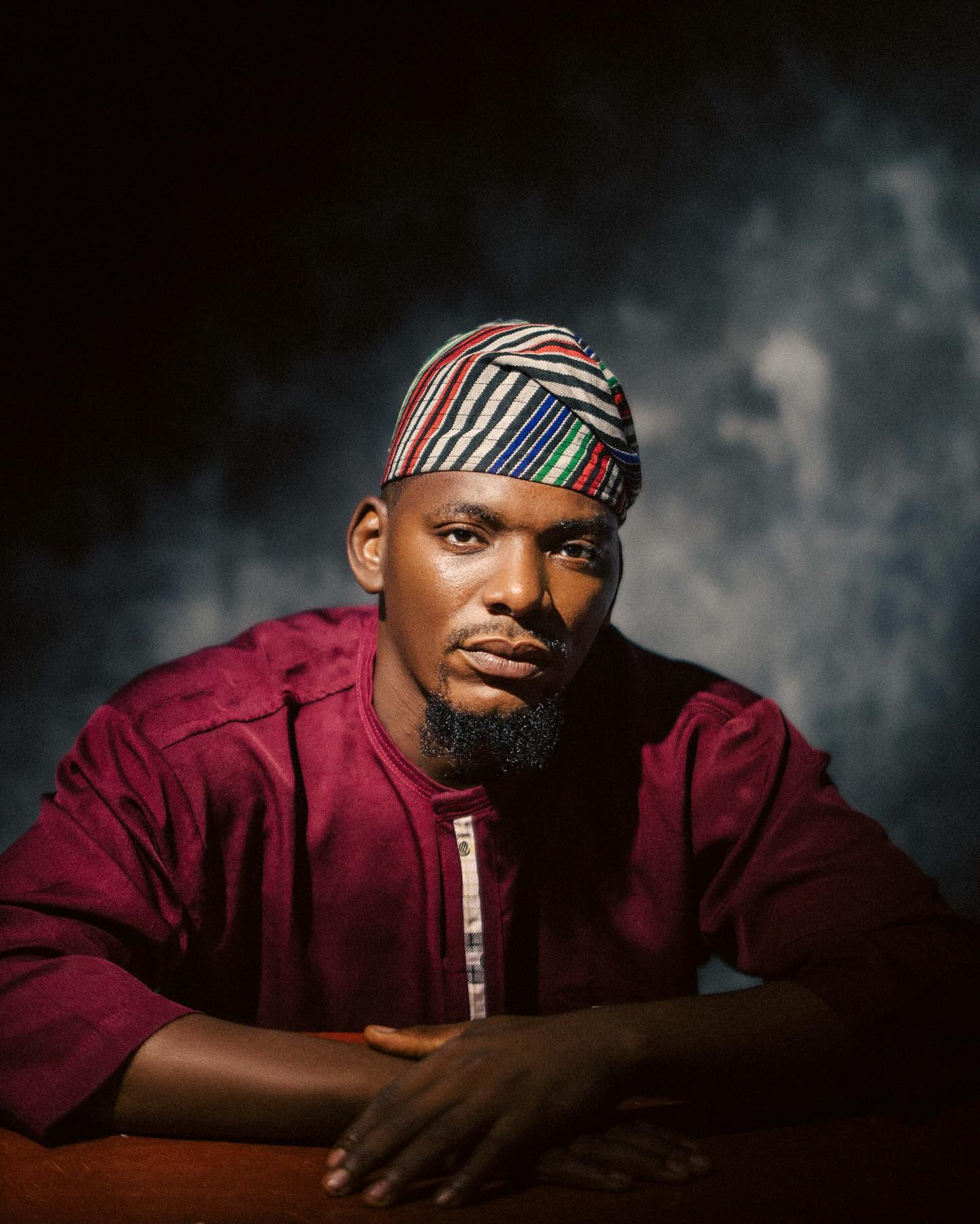
French philosopher, Paul Ricœur, invests considerable pages discussing narrative authority and its relation to memory and recall in his 2004 book, Memory, History, Forgetting. According to Ricœur, we often suffer fictional wounds because narrative authority is hardly clearly defined, left at the whims of the notoriously unreliable human memory. Man must deliberately place himself in control of how the past affects him.
Doing that goes beyond memory; Ricœur highlights that reliable recollection should be sought and is stored in sigils of self-knowledge or ‘self-traces’ in Ricœurian terminology; works of art, architectural structures, photographs, poems. Likewise, Kester Kanayo Onyemaechi understands that when we do not claim the past, we lose the power to dictate how it is interpreted and how that affects us.
Case in point; Egedi series. Kanayo reenacts three old photographs, inset to the left. Daughters mirror their mothers in the foreground. Drawing inspiration from the past is nothing new in Nigerian photography, many center around nostalgia.
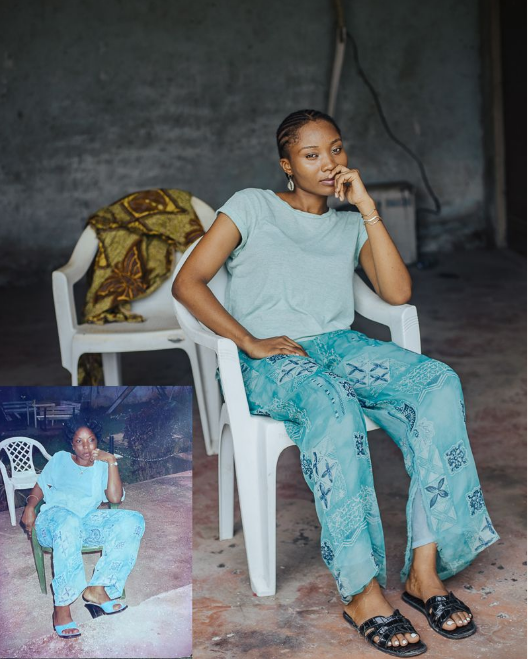
In his juxtaposition, Kester Kanayo Onyemaechi journeys the viewer instead through his notions of memory, and cultural continuity. He restricts his mood board to the very ordinary, a woman posing in the grass in her splendid gold gele, ostensibly just before making her path to a celebration- a friend’s daughter just had a son maybe?
Another frame is taken just after dusk, the mother leans into a chair facing what could be an open air bar or restaurant. She is turned away from the camera; it’s just the close of another business day and calculations preoccupy her attention. Kanayo does not intend to glamourise the past, even though nostalgia is apparent in this project. Neither does he invoke them in sorrow, as the mothers are still living.
This is where one should observe how variables, from posing to hue are slightly altered to reveal that he is in fact celebrating these women. As matriarchs, who have passed on the heavily symbolic inheritance of clothing, as predecessors of the future; the ones who paved the grass so her daughter could have a room full of books, the one who toiled past dark so her daughter could enjoy an afternoon watching the world from her veranda.
How do we approach old photographs? In Kester Kanayo Onyemaechi’s frames, there is a reflective mirror, you are both in the past and in the future, suddenly there is no space for dismissive sneer that ordinarily follows encounters with the olden days. There shouldn’t be.
Motion is a consistent feature of Kanayo’s work, a nod to the oeuvre of Lakin Ogunbanwo, whom CNN identifies as one of the seven leading photographers in Africa. As in the off centre dynamism in Lakin’s shot of Wana Udobaong, Kester Kanayo Onyemaechi effects a similar technique in Avoidance of Lust 1.
However, where Lakin shoots wide to corral the motion around the subject, drawing you into the center, Kanayo’s composition is tight, his subject flees, tries to escape the scene. Her sheet has fallen to her calves and her ass is exposed. Kanayo is teasing and reprimanding you in one swipe; she’s fleeing, man. Motion has an interesting function in the worldbuilding of Light and Shadows.
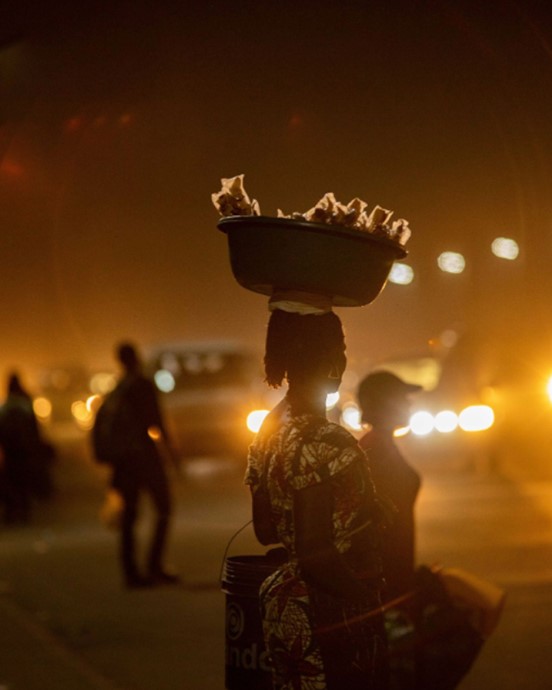
The work in itself is interesting; tone and mood is entirely constructed by, well, light and shadows. The shots are of busy Lagos nights, but its people aren’t the subjects, not immediately. The intense headlights create focal points and the viewer’s perception of space, he has you focusing on the lights; that is the start point.
The subjects here are moving or turned away from us, but unlike in Avoidance of Lust, we are not dreadful intruders. We are followers even, drawn to contemplate alongside the subjects what draws them to the light. Who are they? People we never really see, privileged inhabitants of lighter circumstances as we are, an aboki and a roadside chin-chin hawker, people whose livelihood depend on moving all day, finally moving home.
But Kanayo’s interest is not in us, the viewers, but in his subjects. As they move across Kanayo’s glibly constructed solar system, their aura progressively exudes divinity. In the final frame, our subject is fully transcended, she made it to the light with a camera in hand.
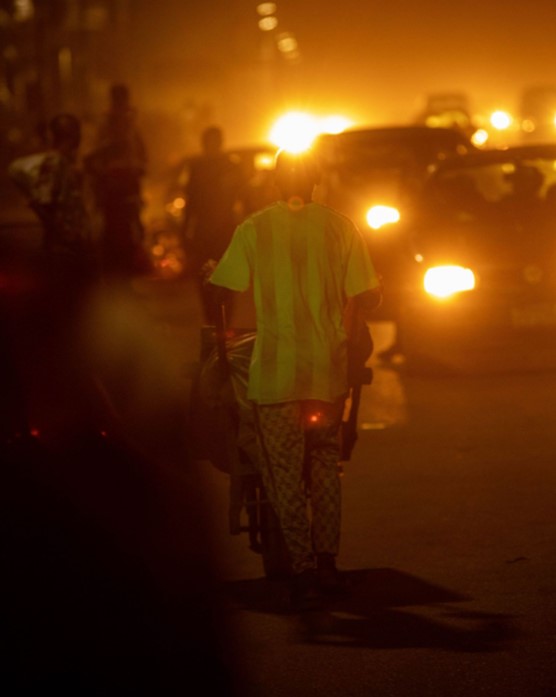
Then the message hits; Who are they? They are people powered by hope. Poverty is viewed from the outside as dejecting and untenable, which it is. We often conclude those people must live very hard lives, that joy was in perpetual eclipse under moons of hunger and bedbugs.
What we are really doing then is imagining our emotional states in what we approximate must be their experience then projecting that onto their faces. And this is the basis of our pity. Kester Kanayo Onyemaechi has flexed the might of the camera, rewriting these foundations in their hope. The hawker doesn’t wake before dawn to catch the first bus to the expressway because she feels handicapped by her lot, she awakes in praise songs, and daydreams of a miracle helper, or a brighter tomorrow for her sons.
Yes, they have hard lives. But not on some cockroach level way the media has helped sensationalise, a depravity we are emotionally alienated from. They have hard lives just like we do, and happy moments like we do, and most importantly hope. This way we can connect to the humanity in the aboki that pushes white beans by the sidewalk, we can see the soul in the mother of two pushing change through the window of a moving bus. There is joy in hope.
What Kanayo has done is hold up liminal space for you and his subjects, trapped in light of the preciousness of life, photography becomes a bridge for intimacy, a salve for an increasingly alienated society.
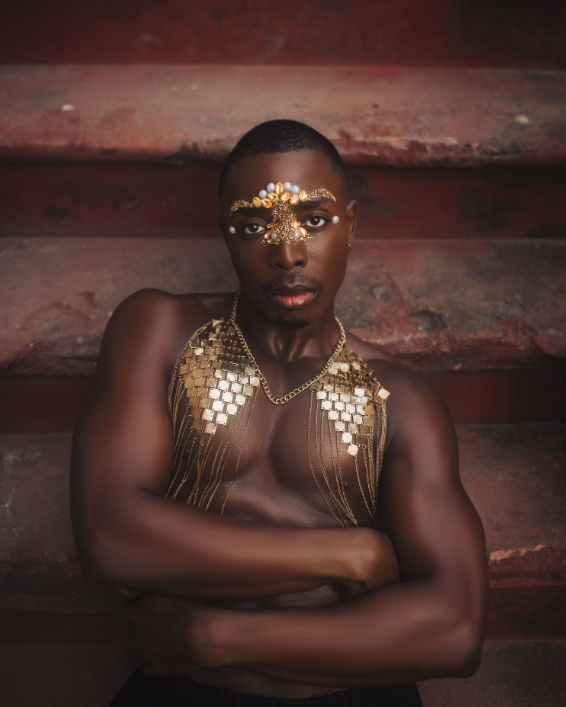
I think of this attitude as my bus rolls over Amansea bridge and onto a barren stretch of the Onicha-Enugwu expressway. We just drove through a checkpoint, and my heart is returning from my mouth.
I came to the decision to japa after an sour experience on one these ubiquitous checkpoints in a region where the task of actually capturing criminals is either the job of local vigilantes or nobody’s business–every young Nigerian man gets the picture. I saw a vox pop the other day where African American drivers confessed that they feared they would be victims of police brutality everytime they hit the road. I laughed, we really are one race, sharing the same injuries across oceans.
It is easy to feel hopeless against a system, to accept that maybe this is our lot as the Negro race. But like the little people seen through Kester Kanayo Onyemaechi’s lens, look at the light.
Ebri Kowaki is a culture journalist and afrofusion commentator. His works have appeared in The Republic, Vanguard Nigeria, Afrocritik, African Writer Magazine, and elsewhere. A 2025 fellow of the Ebedi International Writers Residency, he was shortlisted for the Ikenga Prize in 2024.




